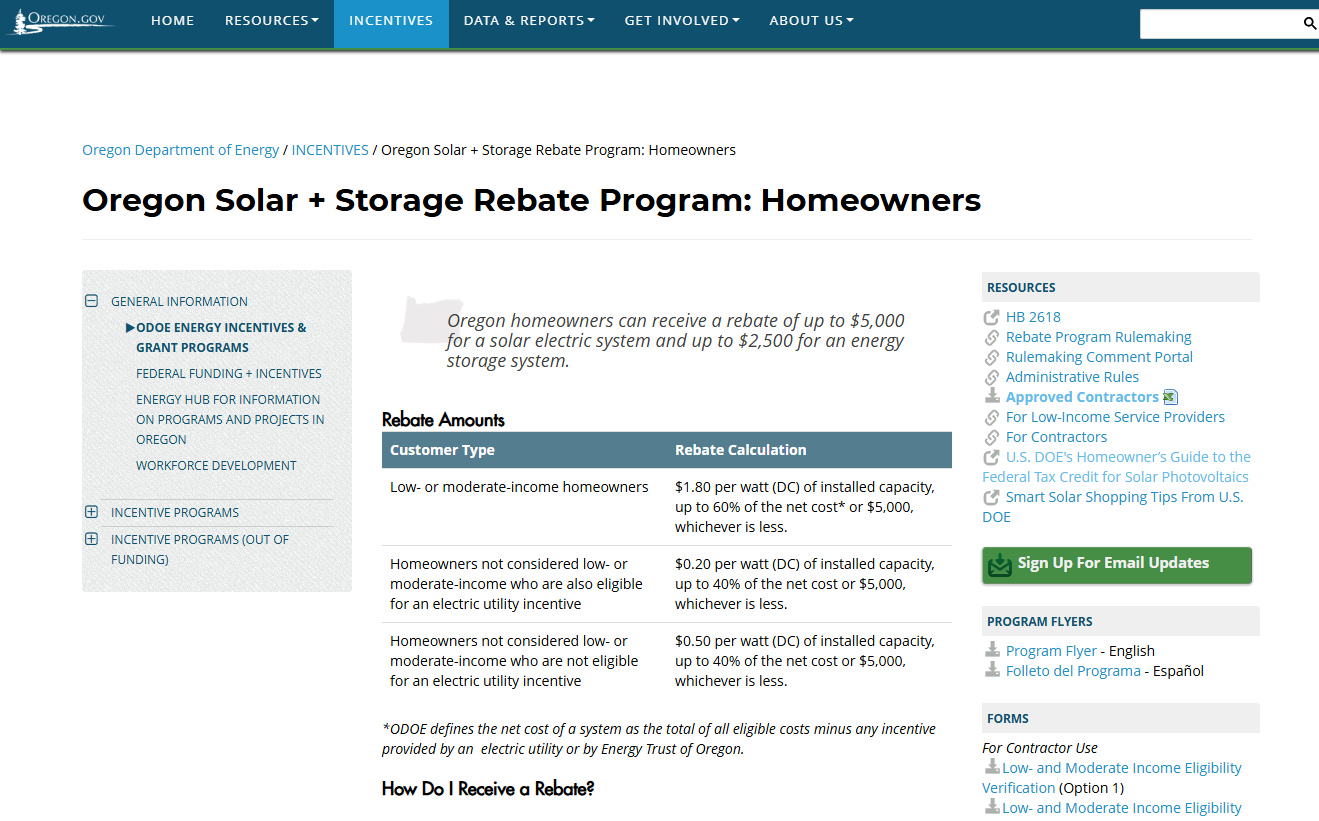Guide to Oregon Solar Incentives 2025
Knowing the Oregon tax credits, rebates, and financing options that are available for installing solar panels is crucial as 2023 is just getting started.
It is important to have the knowledge you need in this guide to make the most of your solar energy investment and take advantage of Oregon’s best solar incentives.
Oregon homeowners can receive a rebate of up to $5,000 for a solar electric system and up to $2,500 for an energy storage system.
View the website at Oregon.gov to learn more
ETO Solar Incentives
The Energy Trust of Oregon (ETO) offers incentives in the form of cash rebates to homeowners and businesses who are customers of Portland General Electric (PGE) or Pacific Power (PP).
These Oregon solar incentives are subject to availability and change rates, and they are calculated on a per-watt basis.
Rebate Qualifications
To qualify for these Oregon solar incentives, you must live or own a business within PGE or PP’s service area. Your building must be:
Residential
Commercial
Industrial
Government-related
Nonprofit, school-related
Agricultural, or
Institutional.
The solar installation that you install must be new, UL-listed, compliant with all standards, and carry warranties on all components.
The system must meet all applicable codes and additional site criteria such as total solar resource fractions, be grid-tied, and be installed by an approved Energy Trust solar trade ally contractor.
Solar Within Reach Program
The Energy Trust also offers a solar incentive in Oregon for low-income families. The Solar Within Reach program provides cash incentives that help low-income families be able to afford to install a solar panel system, which will cut their energy costs in the long term.
Income Qualifications
In order to participate in this Oregon solar incentive for 2023, you must own a residence that falls into one of the following categories: single-family home, multi-family home, manufactured home, floating home, or condo.
As with the ETO’s utility incentives, you must work with an Energy Trust-approved solar trade ally contractor
Finally, your gross annual income must not exceed the program limits based on how many people live in your home:
ODOE Rebate For Solar And Battery Backup Systems
The Oregon Department of Energy solar rebate began offering a new incentive that is meant to help reduce the upfront costs of installing a stand-alone solar energy system or an energy storage system (home solar power plus battery backup). This rebate can cover up to 60% of the net cost of installing your system, with a cap of $5,000 for solar-only systems and a cap of $7,500 for solar plus battery systems.
Eligibility
In order to qualify, your installation site must be property that is completely within Oregon state lines and it must score at least 75% on the total solar resource fraction rating, which evaluates the amount of sunlight that your system will ultimately receive. All equipment for the project must be purchased by an ODOE-approved contractor and installed by that same contractor.
Rebate Calculation
The Oregon Department of Energy solar rebate began offering a new incentive that is meant to help reduce the upfront costs of installing a stand-alone solar energy system or an energy storage system (home solar power plus battery backup). This rebate can cover up to 60% of the net cost of installing your system, with a cap of $5,000 for solar-only systems and a cap of $7,500 for solar plus battery systems.
Eligibility
In order to qualify, your installation site must be property that is completely within Oregon state lines and it must score at least 75% on the total solar resource fraction rating, which evaluates the amount of sunlight that your system will ultimately receive. All equipment for the project must be purchased by an ODOE-approved contractor and installed by that same contractor.
| Customer type | Rebate type |
Incentive Guidelines For Low- Or Moderate-Income Families
To qualify as a household with low- or moderate-income, the sum of all incomes in the household must be at or below the amounts listed below, by household size. All income earners residing at the place of residence, including all family members and roommates who are not related and not part of a separate lease agreement.
| Household Size | Annual Gross Income* | Monthly Gross Income* |
30% Federal Solar Incentives
Good news for this incentive. The Inflation Reduction Act of 2022 extends the 30% federal tax credit until 2032, decreasing to 26% in 2033, and dropping to 22% in 2034 before finally disappearing entirely in 2035 unless there is an action taken again by Congress to extend it. This new law supersedes the previous one that would expire this incentive in 2024.
| Year | Residential | Commercial |
How Does The ITC Work?
The Investment Tax Credit (ITC) works by giving a 30% of the total cost back to you in the form of federal tax credits. For example, if your system costs $20,000, you will earn $6,000 back in tax credits.
What happens if I have more tax credits than tax liability?
That’s no problem. You will not get a cash refund, instead, the remaining credits will be applied to the next tax year.
Oregon Net Energy Metering (NEM)
What is net metering?
Net energy metering is an extremely helpful program that saves you money and can drastically shorten the payback period on a solar energy system. It is one of the best Oregon solar incentive because it provides excellent energy savings in a form of credits and last must longer than most.
Net metering policies vary by state and in fact, not all states allow for net metering. However, Oregon has one of the best net metering policies. It essentially allows you to sell excess energy that your solar panels produce to the grid in exchange for credits on your utility account.
Earn Credits Throughout The Year
When you install a grid-tied solar energy system, your utility company will install a special two-way electricity meter. This meter will measure both the flow of grid electricity into your home and the flow of energy from your solar panels into the grid.
This way, it can determine your net energy usage and if you have used more than you put into the grid, you will pay for that difference, or if you put more energy into the grid than you used, you will receive credits on your account.
This program allows you to essentially use your solar energy even after it is produced since many people are at work or school or otherwise not using much electricity during the daytime when solar panels are producing the most energy.

